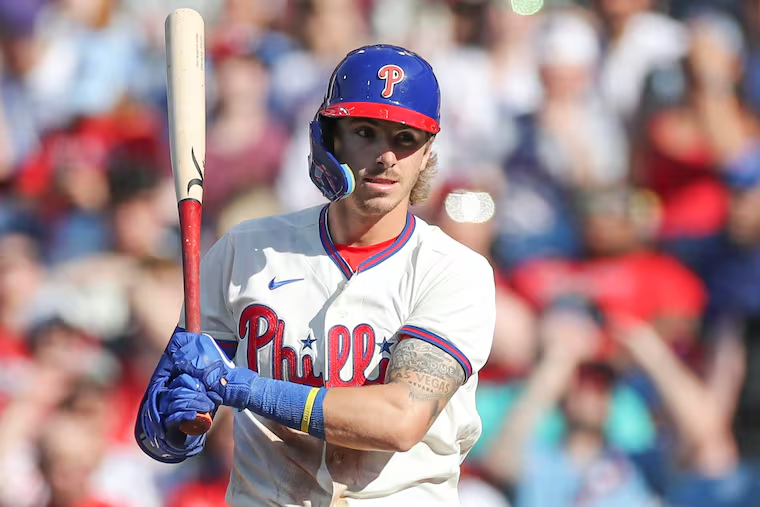Phillies’ Bryson Stott succeeding in the leadoff spot the way he always has: ‘I’m not in a rush’
Stott’s college coach says he was born to hit at the top of the batting order. That starts with his patience, rooted in his knowledge of the strike zone.

CHICAGO — Bryson Stott has developed a reputation. He is young, but he has the batting eye of a veteran. He works his at-bats.
In Game 2 of the World Series against the Astros, he waited patiently as Rafael Montero fed him 12 pitches en route to a walk. On April 5, in Yankee Stadium, he waited patiently as Gerrit Cole fed him eight pitches en route to a double.
“I’m not in a rush,” he said Wednesday.
This is not a new phenomenon. The 25-year-old Phillies infielder claims that his longest at-bat came in 2021, when he was in minor league spring training. He worked a Tigers pitcher — a lefty — to 15 pitches, and hit a home run. Throughout high school and college, he rarely swung at the first pitch.
» READ MORE: The Phillies are huge favorites Thursday night, and we're banking on them winning by multiple runs
“He probably knew the strike zone better than the umpires,” said Stan Stolte, Stott’s coach at UNLV. “If he got called out on a strike three, good chance it wasn’t a strike.”
Stolte said Stott was born to hit leadoff. He makes consistent contact — sometimes, 17 games in a row with a hit to start the season — but he also has plate discipline beyond his years. He sees 4.22 pitches per plate appearance, which ranks 20th in the National League. He doesn’t walk often — just once in 86 plate appearances — which may seem unconventional for a leadoff man, but there is a reason for that.
“According to our advance reports, 72% of the pitches I see are strikes,” Stott said. “I can stand up there for 10 pitches and I don’t even walk. The walks will come. It’s just about swinging at the right ones and hopefully drive something somewhere.”
Stott made his debut in the leadoff spot last season, when Kyle Schwarber missed some time with a calf injury. It lasted about a week, but he took to it right away. His first game was on Aug. 12 at Citi Field. Stott walked up to the plate in the first inning and Mets fans started to boo. Max Scherzer was on the mound. The rookie was not rattled.
He worked Scherzer to six pitches and hit a line drive double to right field. Over those five games, he batted .333. Nevertheless, Stott did not expect to be batting leadoff again in 2023. It seemed it would be either Trea Turner or Schwarber. But on April 10, Stott saw his name penciled in at the top of the lineup. He texted hitting coach Kevin Long: “We’re back.”
Stott was joking, but it did feel, in a way, like he was returning to a familiar place. He has batted leadoff most of his life. He did it throughout high school, college, and the minor leagues. But of course, the big leagues are an entirely different challenge, and he has tried to adjust his approach knowing that Turner and Schwarber are hitting behind him.
» READ MORE: What the Phillies’ Bryson Stott saw from Kyle Schwarber that helped him work on his ‘No. 1′ priority
“I know Trea likes to swing, and I know Schwarber likes to swing, so I want to see as many pitches as I can so they can see as many pitches as they can,” Stott said. “So when they do swing at that first one, they know pretty much exactly what to look for.
“You want those guys swinging, especially if the first one is a get-me-over strike. The more pitches I see, the more pitches they see, and the more comfortable they are swinging at the first pitch.”
Stott points to the Phillies-White Sox game on Tuesday as an example. In the first inning, he took a fastball right down the middle from Lucas Giolito. It was probably one of the better pitches the Phillies saw all night. Giolito ended up no-hitting the Phillies through six innings.
» READ MORE: How Jean Segura helped shape Bryson Stott into the player he is: ‘I really love the kid’
“When a guy like that is throwing well, you don’t want to swing at the first pitch of an inning, because then you take away from Trea’s game, and take away from Kyle’s game,” Stott said. “You want to let them see as many pitches as they can, especially in a game like that.
“If I go up there and get out the first pitch, Trea still might swing at the second pitch. You want to make sure that Trea is as comfortable as he can be going into his at-bat.”
He hopes that approach will have a ripple effect throughout the lineup. It’s too early to make any judgments on whether it’s working, but Stott has settled in. He’s batting .304/.304/.457 in his nine games at the leadoff spot and .365/.372/.482 overall on the season going into Thursday’s game against the Rockies. It doesn’t seem like there’s much incentive for manager Rob Thomson to make a change right now.
But if he does, Stott will keep waiting out those at-bats, regardless of where he hits. Like he said, he’s not in a rush.
» READ MORE: How Phillies shortstop Trea Turner has built a rapport with double-play partner Bryson Stott